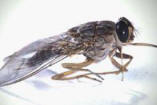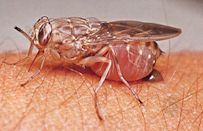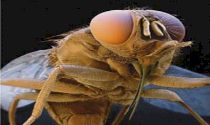
- Possesses a large, widely spaced eyes, forward-projected mouth parts and wings which in rest cover the whole abdomen horizontally, like closed blades of a pair of scissors.
- They are holometaboulos insects, females giving birth to full-grown larvae which rapidly pupate in the soil.
- Fold their wings completely when they are resting so that one wing rests directly on top of the other over their abdomen. Have a long proboscis which extends directly forward and is attached by a distinct bulb to the bottom of their head.
- Local patches of dense vegetation along banks of rivers
- Lakes in arid terrain, and also in dense, wet, heavily forested equatorial rainforest
- Female tsetse mate just once. After 7 - 9 days she produces a
single egg which develops into a larva within her uterus

- About nine days later, the mother produces a larva which burrows into the ground where it pupates.
- The mother continues to produce a single larva at roughly nine day intervals for her entire life.
- Eggs hatch in the female and after larval development, the deposited larvae pupates immediately.
- The pupal stage lasts about 3 weeks.
- The adult fly emerges from the pupa in the ground after about 30 days
- Over a period of 12-14 days it matures, mates and, if it is a female, deposits its first larva.
- Thus 50 days elapse between the emergence of one female fly and the subsequent emergence of the first of its progeny.
- This lifecycle, with a slow reproductive rate and substantial parental investment in the care of young, is a relatively unusual example of an insect with a so-called 'K-type' life history.
- Both sexes are blood feeders and feed on a wide range of hosts, including man.
- This fly is a potent vector for several diseases of animals and man including trypanosomiasis.
- This slow rate of reproduction means that tsetse populations can be eradicated by killing just 2-3% of the female population per day
-
Sleeping sickness: fever, intense itching, headache enlargement of both the spleen and liver, swoleen lymph nodes, severe
 inflammatory, anaemic and leaky blood vessels. Untreated, these symptoms eventually
lead to a coma and then to death.
inflammatory, anaemic and leaky blood vessels. Untreated, these symptoms eventually
lead to a coma and then to death. - Fever
- Swollen lymph nodes
- Headaches
- Somnolence
- Abnormal behaviour
- Loss of consciousness
- Coma
- Sleeping sickness Caused by trypanosome protozoa and transmitted by the tsetse fly.
- Damage caused in the neurological phase can be irreversible.
- It could cause brain damage in those that survived the encephalopathy.
- In Kenya has shown that the tsetse fly hide and breed in thickets.
- The Kathekani tsetse flies are commonly found in game parks, where they are carried by buffaloes and elephants.
- Prevention of sleeping sickness requires avoiding contact with the tsetse fly. Insect repellents and clothing that covers the limbs to the wrists and ankles are advisable. Protective clothing: Wear thick clothing that reduces the amount of exposed skin, such as heavy long-sleeved shirts, long pants, socks and shoes.
- Avoid wearing bright or dark-coloured clothing as these colours attract tsetse flies
- Public health measures have included drug treatment of humans who are infected with one of the Trypanosoma brucei complex.
- Screens and bed nets: Sleep inside screened areas, under a net or in an air-conditioned room.
- Use bed nets that are rectangular in size, impregnated with permethrin* every 6 months and tucked tightly under the mattress before dusk.
- Inspect vehicles for tsetse flies before entering.
- Don’t ride in the back of jeeps, pickup trucks or other open vehicles. The tsetse fly is attracted to the dust that moving vehicles and wild animals create.
- Avoid bushes. The tsetse fly is less active during the hottest period of the day. It rests in bushes but may bite if disturbed.
- Two alternative strategies have been used in the attempts to reduce
the African trypanosomiases. One tactic is primarily
 medical or
veterinary and targets the disease directly using monitoring,
prophylaxis, treatment, and surveillance to reduce the number of
organisms which carry the disease.
medical or
veterinary and targets the disease directly using monitoring,
prophylaxis, treatment, and surveillance to reduce the number of
organisms which carry the disease. - The second strategy is generally entomological and intends to disrupt the cycle of transmission by reducing the number of flies.
Release of radiated males:
This technique involves the rearing of large numbers of tsetse, separation of the males, irradiation of these flies with large doses of gamma rays to make them sterile and then release into to the wild. Since females only mate a few times in their life, generally only once, any mating with a sterile male will prevent that female from giving birth to any offspring.